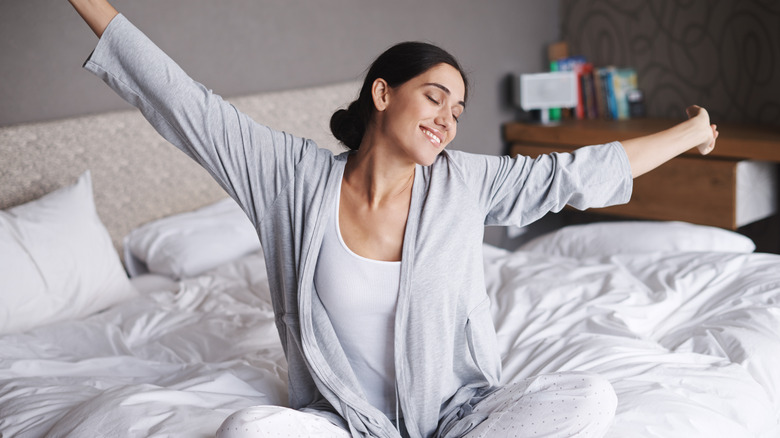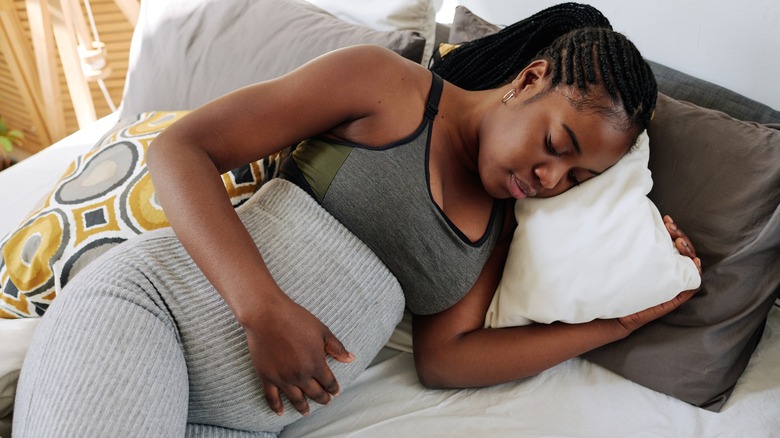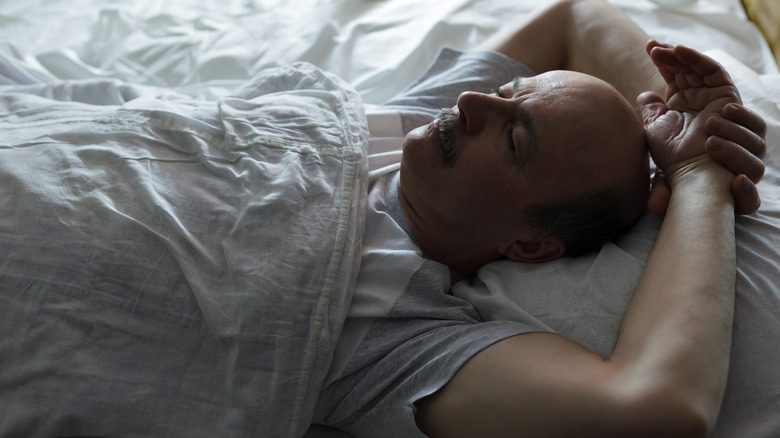This Is The Best Sleep Position For Your Circulation
During waking hours, our body is positioned vertically and constantly in motion. As a result, blood flow is at its peak in the daytime. When our body is positioned horizontally, however — such as while sleeping — blood pools in the lower extremities and the amount of blood circulating throughout the body decreases, according to hospital bed experts at Transfer Master. People with circulation issues (particularly those who are bedridden) may wake up with feelings of numbness, cramping, or hand and foot pain.
To best support our circulatory health as we snooze, side-sleeping is the way to go. Which side we choose to sleep on, however, makes all the difference. While one side will promote blood flow, the other may hinder it. So which is which? You'll want to steer clear of right side-sleeping, sleep specialist Dr. W. Christopher Winter told CNN. Dr. Winter explains that blood returns to the heart on the right side of the body. By placing our weight on our right side as we sleep, we restrict the free flow of those blood vessels. In response to this partial obstruction, our body tends to shift more throughout the night which may impact our sleep (per Dr. Mayank Shukla). Sleeping on our left side, however, optimizes blood flow by keeping our right side free of any compression.
Left-side sleeping may boost circulation for pregnant people
Left-side sleeping may be particularly beneficial for the circulatory health of individuals who are pregnant (via CNN). During pregnancy, the fetus places upward pressure on the organs. We already know that positioning our weight on our right side as we dream reduces blood flow, but the additional stress from the organs during pregnancy may further enhance this restriction, potentially affecting the fetus and the pregnant person.
However, it's important to note that some studies have found no such relationship between sleeping position during pregnancy and circulation-related health risks to the baby. In a 2019 study published in Obstetrics & Gynecology, researchers found that back-sleeping or right-side sleeping during the early and middle stages of pregnancy was no more likely to result in complications than left-side sleeping or alternate sleeping positions.
That being said, sleeping on one's left side during pregnancy may still offer some unique benefits, such as reduced swelling in the lower extremities, reports the Sleep Foundation. For pregnant individuals wanting to stick to their left side, it's advised to do so with your knees bent. Talk to your doctor should you have any questions or concerns.
When left-side sleeping may not be best for circulation
Of course, there are instances in which left-side sleeping may not be advised. Such may be the case for individuals with peripheral artery disease (PAD). PAD is a condition in which blood flow is restricted in the arteries due to the accumulation of plaque, particularly in the legs (per Midwest Institute for Non-surgical Therapy). In more severe PAD cases, one may experience pain or burning sensations when lying down, otherwise referred to as rest pain, according to Charlotte Radiology. The condition is reported to affect over 6.5 million middle-aged to older adults across the U.S.
Right-side sleeping may be preferable for these patients. The reason is that when we're sleeping on our left side, the heart shifts slightly due to gravity, which can impact heart function. When you turn over onto your right side, however, the heart is supported by the lungs and chest muscles. For PAD patients sleeping on their right side, remember to position a pillow between your knees to further support proper spinal alignment.
Back-sleeping is another option for those with peripheral artery disease to help reduce discomfort when sleeping. Positioning yourself on your back with a pillow tucked under the lower back or knees takes the pressure off of the spine. Alternatively, if you experience rest pain, try raising the head of your bed so that your heart is positioned higher than your legs to help boost circulation to the feet.



